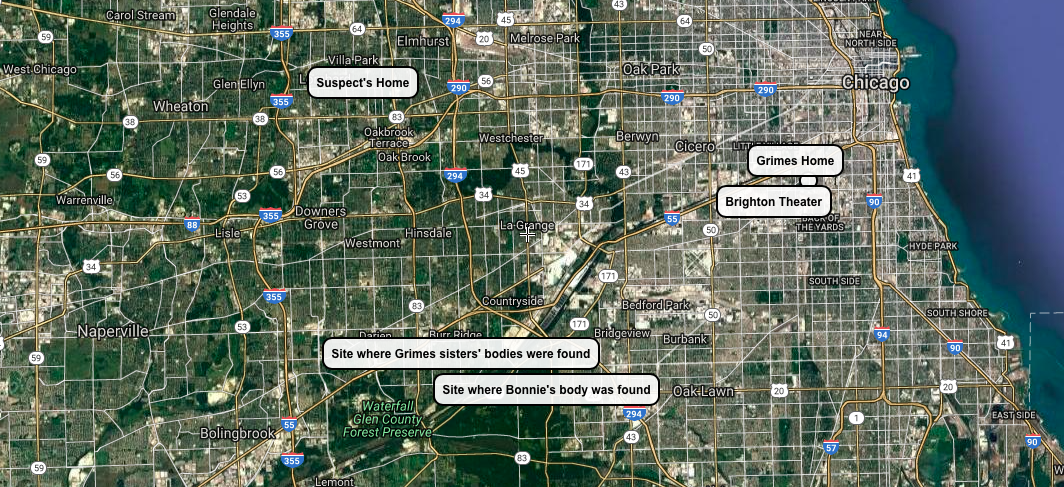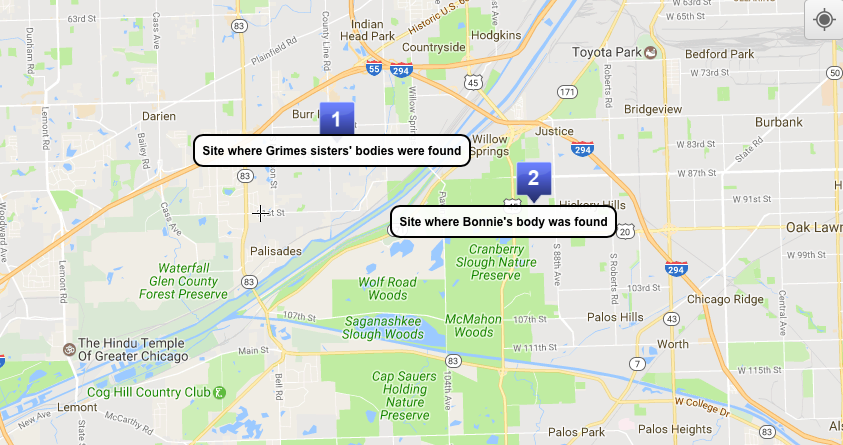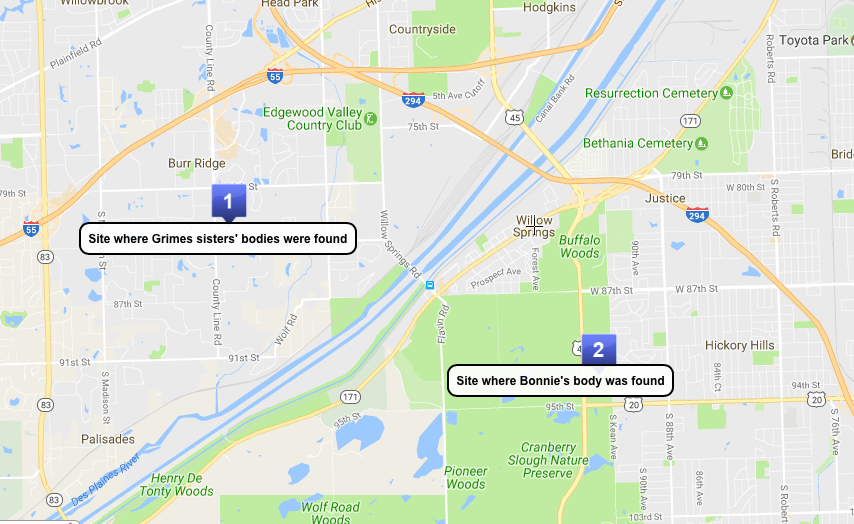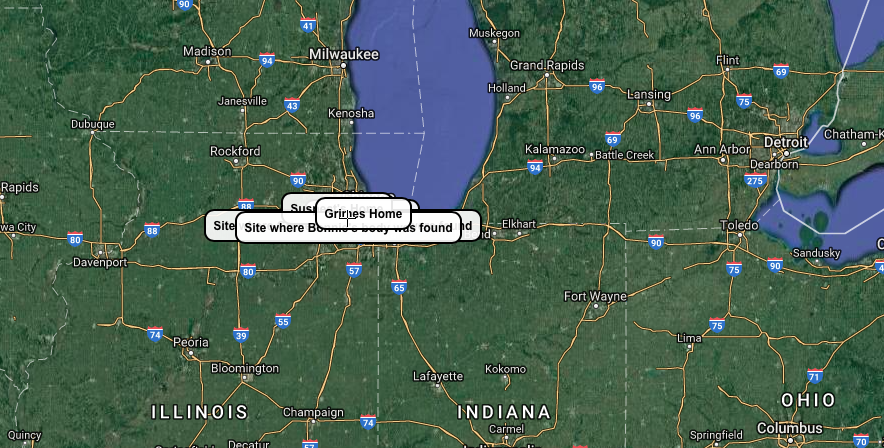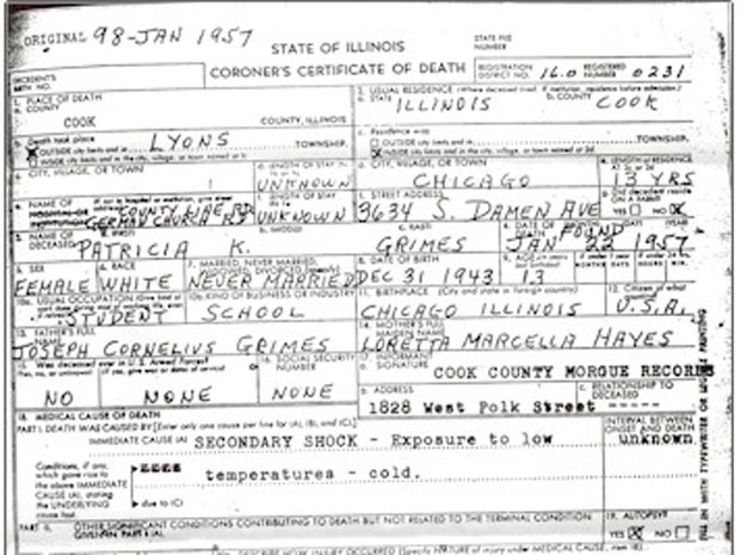A Chicago cold case from 1956 gets some clarity with a fresh look at victimology and criminal profiling — and may be linked to the murder of another teenage girl less than a year later.
This post examines the double-homicide of teenage sisters Barbara and Patricia Grimes in the hopes that justice will eventually be served.
Timeline and Victims
- Barbara Grimes, 15: December 28, 1956
- Patricia Grimes, 13: December 28, 1956
Victim and Homicide Narratives
On the evening of December 28, 1956, the two Grimes sisters attended a screening of Elvis Presley’s film “Love Me Tender” at the Brighton Theater in Chicago, Illinois. The theater was located approximately 1.5 miles from their home in McKinley Park and the girls had $2.50 between them.

The sisters were spotted by Patricia’s friend, Dorothy Weinert, at the first showing of the film and were also later spotted at the concession stand around 9:30pm. Debbie did not notice anything out of the ordinary and reported that the sisters seemed in good spirits. The Grimes sisters planned to stay for the second part of a double feature that evening and were expected home around 11:45pm. When they did not arrive home by midnight, their mother, Loretta, sent their older brother and sister to wait at a nearby bus stop for them. After 3 buses went by without the girls, Mrs. Grimes reported them missing at 2:15am.

The disappearance of the Grimes sisters prompted one of the largest missing persons cases in Chicago history and many thought the girls may have run away — possibly to Nashville to find Elvis Presley or live near him. There were many unconfirmed sightings of the girls after the last confirmed sighting of them at the concession stand in the theater.

On January 22, 1957, a construction worker happened upon the nude bodies of the Grimes sisters along German Church Road behind a guard rail. The weather had recently warmed and the snow and ice that had previously obscured their bodies had thawed. It was believed the girls’ bodies had been tossed from a car. Despite supposed eyewitness sightings of the girls as late as January 3, 1957, expert pathologists determined based on their stomach contents that the girls had not lived longer than 5 hours from the time they were last seen at the theater.

The girls’ bodies were remarkably clean and bore no obvious signs of injury other than three puncture wounds on Barbara’s right chest that may have been inflicted by an ice pick and several bruises and rodent bites. It was determined that Barbara had experienced some kind of sexual intercourse just prior to her death but there was no evidence of violence or rape. Some reports suggest that both girls were violently raped and I came across at least one account stating that the girls were brutally beaten but that this information was withheld from their parents and the media. I cannot find a substantiated report of rape or beating. The official cause of death was “secondary shock” as a result of exposure to the frigid temperature.
Offender Profile
- Caucasian male, likely in his 20s to early 30s in 1956. Several suspects identified at the time were young, in their late teens. I suspect this is too young to have the criminal sophistication to pull off the abduction, control, rape, and murder of two girls.
- Possibility of two perpetrators in order to control the two girls but I think it is more likely this crime was committed by a single offender who took advantage of the girls’ naivety and natural instincts to please and comply
- May have had a gun to better control the victims and intercepted them on their way home from the theater
- Likely used a ruse to trick the sisters into going with him
- Enjoyed boasting about his crimes and taunting collateral victims such as Mrs. Loretta Grimes (the girls’ mother) — placing phone calls to her was his way of re-living the crimes
- Had access to a car in order to transport the girls and dump their bodies
- Of moderate intellectual ability. Would not be considered of genius intellect.
- The offender was not previously known to the sisters. The way their bodies were dumped on the side of the road, with Barbara’s body face-down, her abdomen covering Patricia’s head, indicates that their killer had little to no personal relationship to the sisters and his primary concern was to dump their bodies and leave the scene quickly. Had he known the victims, he might have spent more time with the bodies or, perhaps, buried them.
- The offender had a deep-seated rage that he took out on vulnerable females and children. Likely comitted crimes against women and/or children prior to, and after, this crime.
- Had impulse control problems. May have abused alcohol or drugs or had other impulse control issues such as reckless driving or shoplifting.
- May also have a grievance about siblings or some trauma/disruption in his own family system. May have experienced a significant trauma in his adolescent years.
- I believe Barbara, at a minimum, was raped and the offender’s behavior in dumping the girls’ bodies by the side of the road indicates that he viewed the girls as “trash,” to be disposed of similarly.
- The offender may have some stressors around Christmastime that may have, in part, provoked this attack. The time of year may be significant, or stressful, to him.
Questions
- I have questions about the autopsies. How did the girls die of “secondary shock” from the elements? Was the actual cause of death missed in the initial autopsies? Were the girls strangled or suffocated to death prior to dumping their bodies?
- Were the rodent bites post-mortem? If not, this might indicate the girls were held somewhere that has a healthy population of rodents such as a farm/barn. This might also explain how they died of exposure to the elements (if they were held, nude, in an unheated barn or similar location. That said, I don’t believe they actually died from exposure; I think the autopsy missed the actual cause of death.
- Were they actually rodent bites or were they possibly knicks caused by a knife or other sharp tool? This becomes relevant later.
- The chief investigator for the coroner’s office reported that, contrary to multiple expert pathologist opinions, he believed the girls had been alive up until as late as January 7th. He based this on eyewitness accounts (which we now know to be highly unreliable), snowfall records, presuming that their bodies would have been found sooner, and a thin veil of ice that covered their bodies. I don’t buy these arguments and find the “science” behind them flimsy. The contents of the girls’ stomachs were consistent with the dinner they had prior to leaving for the theater. Additionally, given that this was one of the largest searches for missing persons in Chicago history, transporting the two bodies to the side of the road would have been extremely risky given the media coverage, numerous reported “sightings” of the girls, and the people on the street keeping an eye out for any signs of the girls or anything suspicious. The offender simply wouldn’t have done something like that unless he wanted to get caught. The bodies had likely been there since December 29th. See map below to get a sense of how close their bodies were relative to the theater and how populated and urban an area this was — this would have been extremely risky for the offender to pull off a week after they went missing.
Suspects
- I am puzzled as to why Charles “Chuck” Leroy Melquist was not looked at more as a possible suspect. Melquist was arrested on November 15, 1958 for the September 22, 1957 murder of 15-year old Bonnie Leigh Scott of Addison, Illinois. Bonnie’s body was discovered by some Boy Scouts — she was nude and had been tossed over a guard rail near 95th and LaGrange Road in Palos Township, Illinois.
- A newspaper article from 1958 cites that the names and phone numbers of two girls, both aged 15, who were neighbors of the Grimes sisters at the time of their disappearance were found in Melquist’s bedroom. The girls lived in separate houses but told investigators that around the time of the Grimes sisters’ disappearance, they received several strange phone calls from an unknown man who stated he had obtained their phone numbers off the backs of bus seats. Both girls denied knowing Melquist or the Grimes sisters but said they frequented the Brighton Theater where the sisters were last seen as well as a sweets shop at 35th Street. Their names and phone numbers were found amongst a collection of the names and contact information for 71 Chicago and Cook County girls that were found in Melquist’s possession.
- When investigators questioned the 71 girls on Melquist’s list, 6 of them admitted to being strangled — some until unconscious — by him. Some reported that he had knowledge of Judo techniques and could render a person unconscious with a swift move that left no mark. Were the Grimes sisters on this 71-name list? Was Bonnie?

- The day after Bonnie’s body was found, a mysterious caller rang Mrs. Loretta Grimes’ phone and stated “I committed another perfect crime. This is another one those cops won’t solve and they’re not going to hook it on to Bedwell or to Barry Cook [two early suspects in the Grimes murders that were later cleared].” The caller laughed and then ended the call. Mrs. Grimes stated that she recognized the caller’s voice from a similar phone call she had received in May, 1957, just a few months after her daughters were found deceased.

Charles “Chuck” Melquist, in 1958, at his arraignment for the murder of Bonnie Leigh Scott In that call, the man described how he undressed the girls and remarked about a personal detail regarding one of the girls that was not previously published in the media. Mrs. Grimes noted that the man who called her the day after Bonnie’s body was found had a “distinct voice” and that this unusual quality helped her tie it to the voice of the man who called her shortly after her daughters were murdered. Melquist had a cleft lip which might have made his voice or speech sound unusual or affected. If the caller and the killer were one in the same, he clearly liked attention, provoking Mrs. Grimes, and did not want other men to get notoriety for his murders.
- Note in the above phone call the detail about how the caller undressed the Grimes sisters. Did he have a certain preoccupation with this specific segment of the crime? The clothing the Grimes sisters wore that evening was never found. Reportedly, Patricia was wearing a yellow sweater with blue jeans, a black coat with white stripes on the sleeves, a white scarf on her head, and black shoes. Barbara was wearing a yellow blouse with a gray, tweed skirt, a three-quarter length coat, gray scarf on her head, and white bobby socks with black ballerina shoes. If any of these clothing items are ever found, they would be considered very important evidence in the crime. Melquist stated in his confession that he undressed Bonnie in his car after smothering her with a pillow. He stuffed her crumpled clothes under the seat of the car and kept them there for 2 days before burning them somewhere nearby to his home.
- Importantly, Melquist fits many of the criteria in my suspected offender profile: he was 22-years old at the time of the Grimes sisters’ murders and 23-years old when charged with the murder of Bonnie. He had access to his own car. Melquist admitted to smothering Bonnie with a pillow in his car. Were this similar MO used in the homicides of Barbara and Patricia, it would explain why the coroner had difficulty determining an actual cause of death other than “secondary exposure” to the elements. A glance at the original coroner reports shows that they were looking for drugs, alcohol, poisons, and overt signs of a beating or strangulation. Finding none of these, they were perplexed. Suffocation by pillow would leave little trace behind. Given that Melquist stated he smothered Bonnie in his car, this might explain why the Grimes sisters’ bodies were located so near to the theater they were last seen at. If their abductor took them in a car, pulled off somewhere, and smothered them, he would only need to drive a short distance to dispose of their bodies. What is particularly striking to me is how close the location of the Grimes sisters’ dump site is to where Bonnie’s body was found — about 7 miles driving (see maps below). What is next most striking is that all 3 girls were tossed, nude, by the side of a guard rail.
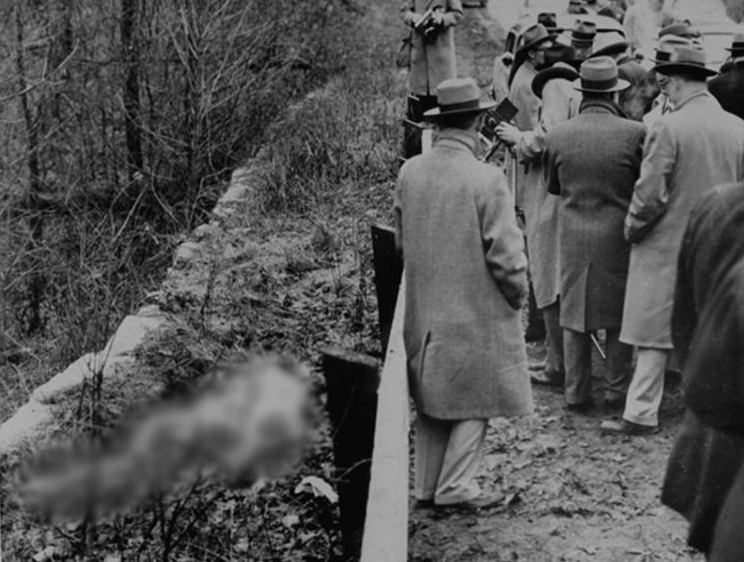
- On disposing of Bonnie’s body, Melquist stated “I pushed it across the guard rail just like a sack. She was lying on her back. I dragged her by the feet down the embankment 15 feet to this small thicket. Then I left.” The way Melquist describes this scene resonates with a murderer who viewed his victim as “trash” and not as a human being — the way he labels her as “it,” “like a sack,” and that he dragged her body, rather than carry it. Details in the murder of Bonnie Leigh Scott also suggest that Melquist was of average intelligence, similar to my suspected offender profile. He stated that he drove around with Bonnie’s body in his car, looking for a place to leave her body that it was unlikely to be found. For some reason, he chose near a guard rail and her body was discovered shortly thereafter. Not exactly the most remote place he could find — and less than a half-hour drive from his home.
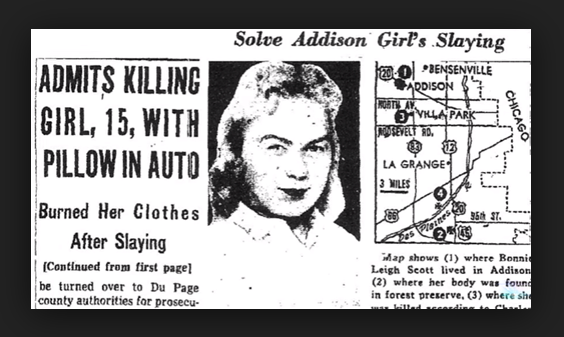
- I am particularly struck by the fact that Melquist admitted to returning to the scene of Bonnie’s disposal four days after her murder, on September 26, 1957. This suggests a psychological need to stimulate himself by re-living certain experiences and places related to the murder. This behavior is very much in line with someone who would call Mrs. Grimes to taunt her — twice — by phone about the murders of her daughters. This is also exceptionally risky behavior, as is phoning Mrs. Grimes. But, Melquist didn’t stop there. He returned to the scene of Bonnie’s dump site three times! In line with this self-stimulation, Melquist also admitted to driving Bonnie’s grandmother around in the days after her disappearance, “helping” the poor woman look for her missing granddaughter. This kind of psychological torment and dominance, these mind games, are very specific and appear multiple times in the story of Bonnie Leigh Scott. It would not surprise me at all if there was some link to the person who called Mrs. Grimes to torment her. With 71 names on his list, Melquist certainly liked calling young girls he did not know. We at least know that much.
- Melquist admitted to decapitating Bonnie post-mortem and kicking her head away from her torso — another behavioral clue that suggests he viewed her as less than human, as trash. He took the same 4-inch knife used to decapitate her and plunged it into her body, post-mortem, several times, creating deep gashes. I would be curious to know if these gashes bore any resemblance to the cuts on Barbara Grimes’ right chest. I would also be curious to know if the cuts to Barbara were caused post-mortem. Given that the Grimes sisters were killed before Bonnie, it is possible we are seeing an escalation in the offender’s behavior with Bonnie, as he decapitates her and mutilates her body in a more grotesque fashion.
- Note the language Melquist used when describing this aspect of the crime to investigators: “I was going to bury the body. I cut the neck a little bit and that detached her head from the body. Then things were a little vague from then on but, for some reason, I had an urge to cut some more.” Notice the distancing language he uses: “the body, the neck.” Bonnie is not a human being to him. Notice also how he describes “an urge” to mutilate her body. This was not done out of necessity (in example, dismembering a body in order to more easily transport it). This was done solely in response to sadistic urges.
- Finally, we know serial offenders tend to engage in ritualistic behavior. There are many common threads in the murders of the Grimes sisters and Bonnie: location of dump sites, age, gender, bodies were found nude in the open near a guard rail, it is possible all were suffocated, it is likely all were raped, and sadistic taunts and games from a male in the days and months after the crimes. Melquist was charged and convicted of the crime of killing Bonnie Leigh Scott. If he didn’t also murder the Grimes sisters then there was either a second killer with the same MO and ritualistic behavior at the exact same time prowling the streets of Chicago, or they convicted the wrong man for the murder of Bonnie. I just find it incredibly hard to believe that the murders of the Grimes sisters are unrelated to the murder of Bonnie Leigh Scott.
- Melquist was sentenced to 99 years for the murder of Bonnie Leigh Scott. He served only 11 years. Melquist passed away in 2010 after starting a “second life,” — getting married and having children. A public search reveals no further crimes that he was convicted for or pled guilty to after Bonnie’s murder. I suspect he simply was just not caught or had connections/was able to pay his way out.
- A final note: some theorists are interested in Silas Jayne and his employee, Kenneth Hansen, as possible suspects. At the time of the murders, Silas was 50-years old, which makes him much older than my proposed offender profile but I suspect he may have only helped in covering up the murders (When Silas murdered, it was generally motivated by attempting to cover up other crimes and he was murdering the witnesses). Kenneth, on the other hand, would have been 23-years old — right in the ballpark — and his murders were generally sexually-motivated and sought to humiliate and terrify his victims. Silas was convicted of rape as a teenager and, later for conspiracy to murder his half-brother, George, when Silas was 58-years old. He was born and raised in Chicago and lived there at the time of the Grimes sisters’ murders, as did Kenneth. Silas was known to molest many of the young girls who worked at his horse stables and his employee, Kenneth, was was found guilty of the triple murder of John, 13 and Anton, 11 Schuessler and their friend, Robert Peterson, 13.

- Similar to the dumping of the Grimes sisters by the side of the road, the three boys were left in a ditch in the Robinson Woods Forest Preserve on the northside of Chicago. Like the Grimes sisters, the 3 boys were piled on top of one another. Also similar to the Grimes disappearance, the boys were abducted while on their way from the theater. Allegedly, Kenneth lured the boys to the Idle Hour Stables, owned by Silas Jayne, with a story about showing them the horses there (could he have fed the Grimes sisters a similar story?). At the stables, Robert discovered Kenneth molesting the two brothers and Kenneth became enraged, killing all 3 boys. Silas helped Kenneth place the bodies in a station wagon and dispose of them, fearing that if the crime were discovered on his property, he would be ruined. Of note, the barn in which the murders took place was burned by arson on May 15, 1956. Kenneth had preyed on hundreds of young boys, stalking them on the streets of Chicago, before he was finally convicted of the Schuessler-Peterson murders in 1995. Silas was suspected in the disappearances of Ann Miller, 21, Patricia Blough, 19, and Renee Bruhl, 20, who were last seen on July 2, 1966, boarding a boat similar to one owned by Silas’ employee. Given Kenneth’s history of molesting and murdering three young boys on the same occasion, and Silas’ history of crime and of helping Kenneth cover up a triple homicide, I find them both to be good candidates for the abduction and murder of the Grimes sisters.
- Despite the similarities in the Grimes murders and the Schuessler-Peterson murders, there are two primary facts that detract from Silas and Kenneth being the killers of the Grimes sisters: 1) gender — Kenneth was only known to molest and kill prepubescent males. The Grimes sisters would have been quite a departure for him. While Silas was known to molest adolescent females, he was not known to murder them. The only persons Silas was suspected of murdering were for secondary gains such as protecting gangster interests or his business ventures. 2) I believe strongly that the girls were murdered in close proximity to where they were found. If you look at the below maps, you can see how close the dump site is to the theater. To travel north to the Silas farm would not make sense.
- Conclusion: whoever killed the Grimes sisters also killed Bonnie Leigh Scott. The behavioral similarities are just too alike. The Shuessler-Peterson murders are unrelated.

Mrs. Loretta Grimes
The murders of Barbara and Patricia Grimes remain unsolved. This is still an open case and their mother, Loretta, never stopped seeking justice for them. She passed away in 1989, never finding the man who killed her beloved daughters. The clothing Patricia, Barbara, and Bonnie were wearing when they were murdered has never been located. It may have been burned to hide evidence but there is also some possibility their killer kept the clothing, or pieces of it, as mementos. Perhaps these are somewhere, waiting to be found — in a family attic, thrift store, or safe deposit box. If you have any information about the abduction and murders of the Grimes sisters, please contact the Chicago PD at (312) 746-7000 or the Cook County Cold Case Team at (708) 865-4790. You can also submit a tip online anonymously: http://www.cookcountysheriff.org/crimetip.html
Relevant Links
http://archives.chicagotribune.com/1958/11/19/page/1/article/slayer-of-girl-15-hopes-he-gets-chair
http://il.findacase.com/research/wfrmDocViewer.aspx/xq/fac.19620928_0000504.IL.htm/qx
https://www.facebook.com/groups/GrimesSisters/
